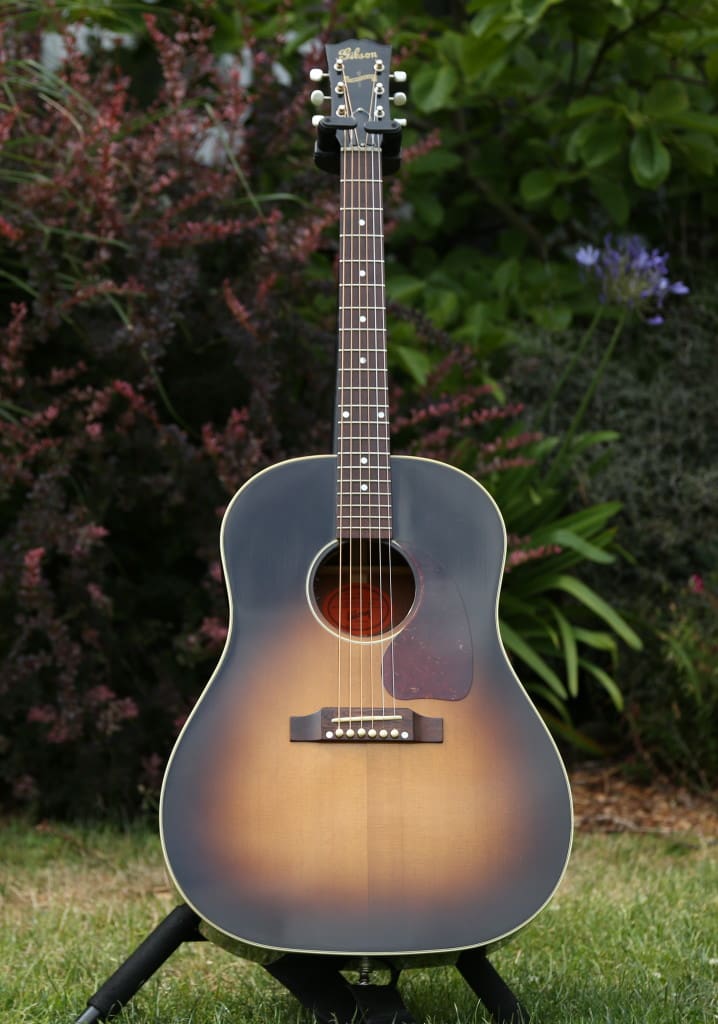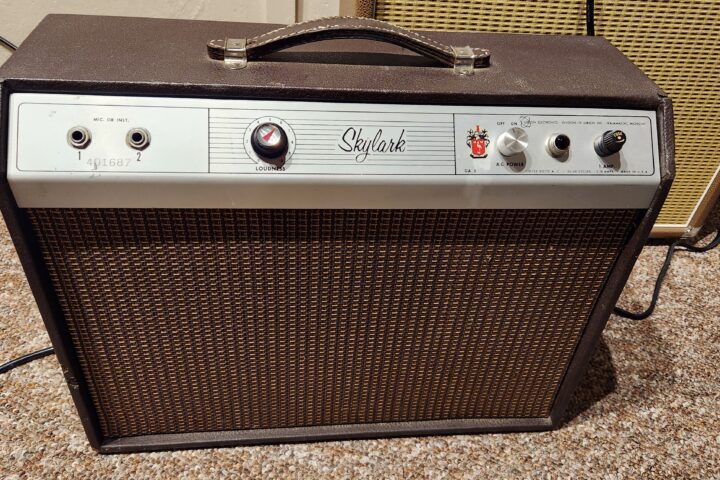Relaxing on his tour bus before a gig, John Hiatt reaches for just one guitar: a 1947 Gibson LG-2. He bought the instrument from Nashville’s Gruhn Guitars around 1986 for around $800 and it has since remained a constant picking and songwriting companion. “I picked it up and immediately it had that thing where it resonates with you and you get all connected up with it, chords just feel right,” the singer-songwriter says. “I carry it with me on the road. I love it. I’d like to play it onstage but it’s just a little too tender and fragile.”
Though he’s sported plenty of different guitar models over the years, when it comes to acoustic sessions, Hiatt is often seen playing ‘80s-era Gibsons onstage. “I just like the way they thump,” he says. “And for the rhythm-y thing I do, they just fit. It’s almost like you get an extra beat out of them on the bottom end, when you get them going.”
In 2014, Hiatt released Terms of My Surrender, his 22nd studio album. It’s a bluesy, intimate affair filled with some great Hiatt tunes. On the aforementioned tour bus, Hiatt performed two songs from the album for the Fretboard Journal: “Marlene” and “Long Time Coming.” He also talked gear with us and hinted that Little Village (the supergroup he formed with Ry Cooder, Jim Keltner and Nick Lowe) has a chance of reuniting.

FJ: When you first moved to Nashville as an 18 year old songwriter, what guitar were you playing?
JH: I think I still had my Gibson Hummingbird. It was a nice guitar. It got stolen … I can’t remember if it was in Nashville or on one of many trips back to Indianapolis to get fed. I used to hitchhike home… to eat! I’d eat for a week and then come back to Nashville.
I bought that guitar at a combination pawn shop and music store, downtown [Indianapolis]. They had the most extensive glass lined, plush showcase of Gibson guitars. I still haven’t seen anything like it. Every make: Les Pauls, Les Paul Jr’s, L-5s, whatever the heck you wanted, they had.
FJ: How were you able to afford the Gibson?
JH: I was working for a year before I came to Nashville. I had a job at an insurance company! I was one of the stock boys in the basement, who put all their paper products to gather to send to their salesman.
While everyone else was getting their chops going or learning licks, all I wanted was a couple of chords. I got a Mel Bay book and as soon as I got a few chords, I started writing songs. And then I decided to move to Nashville. It was the closest music center to Indianapolis. I was too much of a Midwest kid to think of going to LA. New York was too scary. And also there was just the peculiar music coming out of Nashville at that time. There was a group called Area Code 615, a bunch of session guys at the time, they were making these instrumental records, like “Lady Madonna” with banjo. That was intriguing.

FJ: Do you have a songwriting process or routine?
JH: I don’t have one. I try to write [a song]… that’s my process! I pray a lot. Over the years, I’ve tried some trickery to make it happen and pretty much worn it all out. Most of the time, for me, when I’ve stopped working, I’d say, ‘Oh shit, I can’t write.’ You have writer’s block when you tell yourself you have writers block.
As long as you can get the next one, you can be hopeful that there’s a next one coming. I don’t generally rush things.
FJ: Do you know from the start whether a song will turn out to be an acoustic or electric one?
JH: The song is the first thing, music, melody and lyrics. It’s always about the song. And I don’t really have a sound in my head about how it should go. The exciting part of recording for me is, Here it is, let’s see what happens, what it sounds like, let’s see how the musicians play it, this gathering at this moment, what kind of music does that make.
FJ: You’ve sat on some songs for a long time before releasing them…
JH: That’s because I’m always scraping the barrel [laughs]! Usually we cut more than we put on. I usually have some laying around. And it doesn’t mean they’re bad, it just means they didn’t fit the record.
FJ: Can you tell us a bit about the new record?
JH: I did it with the same guys I’ve been out playing with for four or five years. We added a harmony singer [Brandon Young] and have Doug Lancio on guitar. I pretty much just let him do his thing.
I had an idea of an approach: The song, the acoustic guitar, in the forefront. I wanted to hear my guitar for a change. A lot of the time [on the record], I’m playing a cheap old Harmony flattop that Doug had laying around. We put a DeArmond pickup in it and we ran it through an old Silvertone amp of mine. I also used my J-45 with a Fishman piezo rig in it. We ran that through an amp as well. We use the amp for just a little grizzle, to make it not pretty. We’ve done pretty, we’re not pretty. Life’s not pretty.

FJ: What’s the story behind the white Tele that Nick Lowe gave you?
JH: Well, we were making the second half of Riding with the King in 1983. I spent the summer in London, recording and just goofing around. I played the Tele quite a bit, and at the end of recording, he gave it to me. I love the guitar, it’s the only Tele I’ve ever played, really.
I got this guy in Texas who makes recreations of the original pickups to put a set in there. They’re not hot rodded, you just don’t have to worry about them. The tuning pegs are the same, the three tree bridge is the same, everything else is the same. It’s a ’57. I was playing it on the road for years but I stopped doing that about four years ago. I got too worried, not because of what it might be worth but because of emotionally what it’s worth. I didn’t want to lose it, break it or have it stolen.
There’s a guy in Nashville, Jeff Senn, who does Tele recreations. He made me an ash body ’57 style, and then another one that was kind of like a ’53 (Blackguard) with alder. I take those on the road. They sound great and play great. It’s just not a ’57 Tele. But it’s pretty damn close.
FJ: Do you still talk to Nick Lowe?
JH: I saw him in Australia. We were on the same festival. It was so great to see him. In fact, we were talking about maybe playing again.
FJ: Think Little Village will ever reunite?
JH: I think anything could happen. Nothing would surprise me. When we hit it, it was pretty special music, for me. Some nights we didn’t hit it, but when we did…
FJ: Did the Little Village recording session have a different vibe than the live shows?
JH: I don’t know if they’ll all agree with me, but I think we all felt some pressure to come up with something more than the sum of the parts. I certainly felt that, anyway. But you know what, I put that record on and it’s a really good record! People at the time felt like it thought be more raggedy and rock & roll, like Bring the Family was, but, as it ages, I think, well, no it shouldn’t. It’s a separate thing and it’s a pretty cool record. The only different approach would be to let us bring our own individual songs in next time, as opposed to trying to co-write everything.
FJ: For a typical gig these days, what guitars are you bringing onstage?
JH: I take a [Ren Ferguson-built Gibson] J-200 and J-45 and two backups of the same. And then I’ve got the two Teles.

FJ: Have you kept all of your guitars over the years? I know you used to have some vintage Harmony guitars…
JH: Doug is playing half of my old guitars. He has my red Stratatone. I still have all that stuff at home. Those funky amps, too. When I was a kid, we had those Silvertone piggyback amps and we coveted those beautiful cream Tolex Bandmasters. Now, we come to find that we love the Silvertones…that was the sound of all those guys that we loved; that’s where they were getting it!
FJ: Do you still buy gear?
JH: You know, it’s gotten so ridiculous. I was buying the cheap plywood guitars when you could get them for $100. I tend to get attached to a couple of guitars, but I love guitars and I love old amps… just the different sounds.
FJ: Anything gear-wise that you covet but haven’t found yet?
JH: I find it best not to covet if possible. It just sort of screws you up. I’d rather just see what comes. Be open.
Photography: Adam Bale


